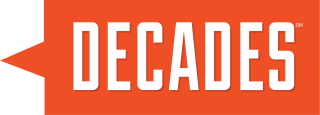| Ion Life | |
|---|---|
 | |
| Launched | February 19, 2007 |
| Owned by | Ion Media |
| Picture format | 480i (SDTV) |
| Country | United States |
| Language | English |
| Broadcast area | Nationwide (via OTA digital TV) (U.S.coverage: 63%) [1] |
| Headquarters | West Palm Beach, Florida |
| Sister channel(s) | Ion Television Qubo |
| Website | IonLife.com |
Availability | |
| Terrestrial | |
| Affiliated with Ion Television owned-and-operated and affiliated stations in most markets | See list of affiliates (channel carriage varies depending on the station, although the network is usually carried as a third digital subchannel) |
| Satellite | |
| Dish Network | Channel 1000 |
| Cable | |
| National feed available on select U.S. cable systems | Consult your local cable provider or program listings source for channel availability |
| IPTV | |
| AT&T U-verse | Channel 468 |
| Verizon FiOS | Channel 492 |
Ion Life is an American digital broadcast television network that is owned by Ion Media.

The United States of America (USA), commonly known as the United States or America, is a country composed of 50 states, a federal district, five major self-governing territories, and various possessions. At 3.8 million square miles, the United States is the world's third or fourth largest country by total area and is slightly smaller than the entire continent of Europe's 3.9 million square miles. With a population of over 327 million people, the U.S. is the third most populous country. The capital is Washington, D.C., and the largest city by population is New York City. Forty-eight states and the capital's federal district are contiguous in North America between Canada and Mexico. The State of Alaska is in the northwest corner of North America, bordered by Canada to the east and across the Bering Strait from Russia to the west. The State of Hawaii is an archipelago in the mid-Pacific Ocean. The U.S. territories are scattered about the Pacific Ocean and the Caribbean Sea, stretching across nine official time zones. The extremely diverse geography, climate, and wildlife of the United States make it one of the world's 17 megadiverse countries.
Digital television (DTV) is the transmission of television signals, including the sound channel, using digital encoding, in contrast to the earlier television technology, analog television, in which the video and audio are carried by analog signals. It is an innovative advance that represents the first significant evolution in television technology since color television in the 1950s. Digital TV transmits in a new image format called HDTV, with greater resolution than analog TV, in a wide screen aspect ratio similar to recent movies in contrast to the narrower screen of analog TV. It makes more economical use of scarce radio spectrum space; it can transmit multiple channels, up to 7, in the same bandwidth occupied by a single channel of analog television, and provides many new features that analog television cannot. A transition from analog to digital broadcasting began around 2006 in some countries, and many industrial countries have now completed the changeover, while other countries are in various stages of adaptation. Different digital television broadcasting standards have been adopted in different parts of the world; below are the more widely used standards:

Terrestrial television is a type of television broadcasting in which the television signal is transmitted by radio waves from the terrestrial (Earth-based) transmitter of a television station to a TV receiver having an antenna. The term terrestrial is more common in Europe and Latin America, while in the United States it is called broadcast or over-the-air television (OTA). The term "terrestrial" is used to distinguish this type from the newer technologies of satellite television, in which the television signal is transmitted to the receiver from an overhead satellite, and cable television, in which the signal is carried to the receiver through a cable.
Contents
Originally from its February 2007 launch, Ion Life had primarily featured lifestyle programming, consisting of shows pertaining to subjects such as health and wellness, cooking, home decor and travel. In 2019 with expanded cable carriage, Ion Media switched the network's schedule to match the main format of Ion Television, featuring day-long marathons of one series per day, along with a late-night block of paid programming.

Ion Television is an American free-to-air television network that is owned by Ion Media. The network first began broadcasting on August 31, 1998 as Pax TV, focusing primarily on family-oriented entertainment programming; it rebranded as i: Independent Television on July 1, 2005, converting into a general entertainment network featuring mainly recent and older acquired programs; the network adopted its current identity as Ion Television on January 29, 2007.
A marathon is an event in which viewers or readers engage many hours-worth of media in a condensed time period. This phrase represents a two-fold shift from binge-watch in that it incorporates other media and it reduces the negative connotations associated with bingeing. In the 2014 book Media Marathoning: Immersions in Morality, Lisa Perks describes media marathoning as a “comprehensive and complimentary phrase” that “connotes a conjoined triumph of commitment and stamina. This phrase also captures viewers’ or readers’ engrossment, effort, and sense of accomplishment surrounding their media interaction.” Netflix Executive Todd Yellin is quoted as saying "I don't like the term 'binge,' because it sounds almost pathological. 'Marathon' sounds more celebratory."
An infomercial is a form of television commercial, which generally includes a toll-free telephone number or website. Most often used as a form of direct response television (DRTV), long-form infomercials are typically 28:30 or 58:30 minutes in length. Infomercials are also known as paid programming. This phenomenon started in the United States, where infomercials were typically shown overnight, outside peak prime time hours for commercial broadcasters. Some television stations chose to air infomercials as an alternative to the former practice of signing off. Some channels air infomercials 24 hours. By 2009, most infomercial spending in the U.S. occurred during the early morning, daytime and evening hours, or in the afternoon. Stations in most countries around the world have instituted similar media structures. The infomercial industry is worth over $200 billion.
Ion Life is carried mainly as a digital multicast service on Ion Media Networks-owned stations as well as select Ion Television affiliates (and is primarily placed on the third subchannel); its base national feed is also available on select cable and satellite providers. In a few select markets, Ion Life has main channel placement, allowing it must-carry coverage on local cable and satellite services.
In broadcasting, digital subchannels are a method of transmitting more than one independent program stream simultaneously from the same digital radio or television station on the same radio frequency channel. This is done by using data compression techniques to reduce the size of each individual program stream, and multiplexing to combine them into a single signal. The practice is sometimes called "multicasting".
In the broadcasting industry, a network affiliate or affiliated station is a local broadcaster, owned by a company other than the owner of the network, which carries some or all of the lineup of television programs or radio programs of a television or radio network. This distinguishes such a television or radio station from an owned-and-operated station (O&O), which is owned by the parent network.

Cable television is a system of delivering television programming to consumers via radio frequency (RF) signals transmitted through coaxial cables, or in more recent systems, light pulses through fiber-optic cables. This contrasts with broadcast television, in which the television signal is transmitted over the air by radio waves and received by a television antenna attached to the television; or satellite television, in which the television signal is transmitted by a communications satellite orbiting the Earth and received by a satellite dish on the roof. FM radio programming, high-speed Internet, telephone services, and similar non-television services may also be provided through these cables. Analog television was standard in the 20th century, but since the 2000s, cable systems have been upgraded to digital cable operation.












